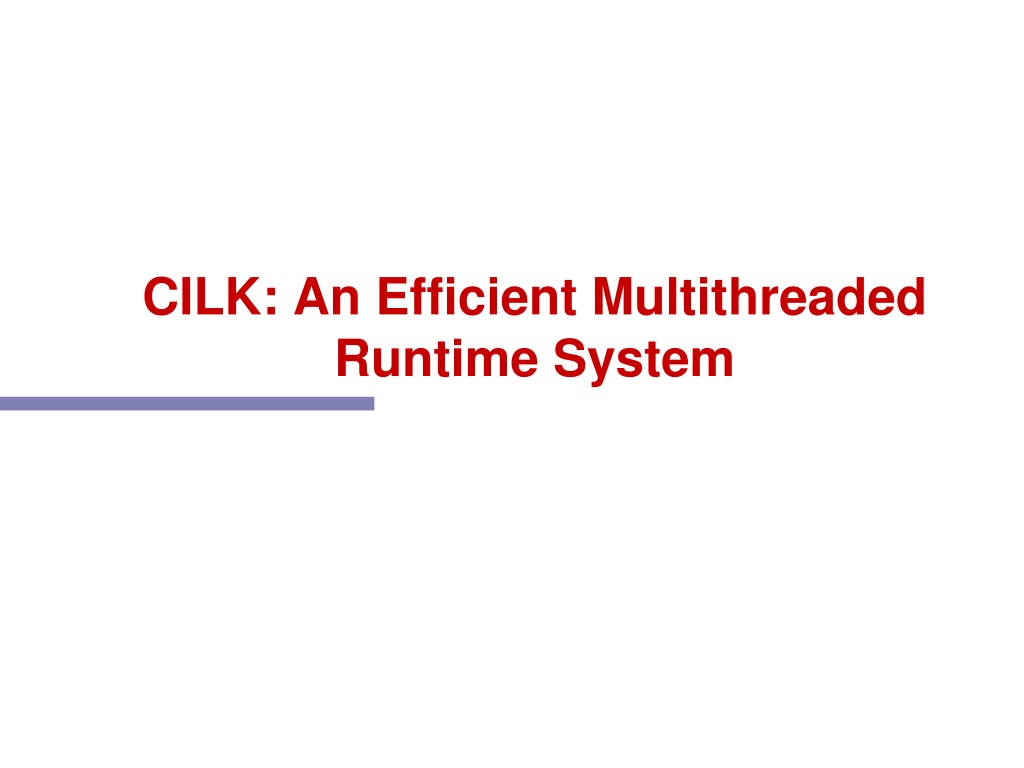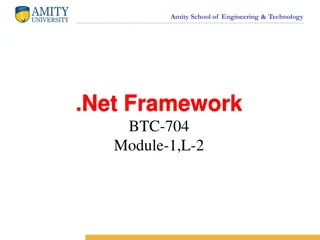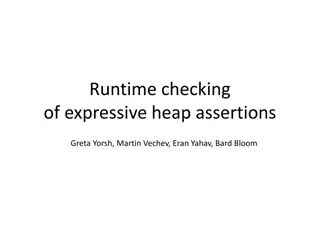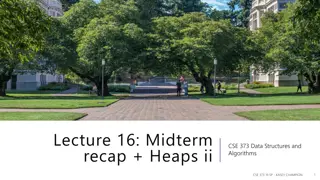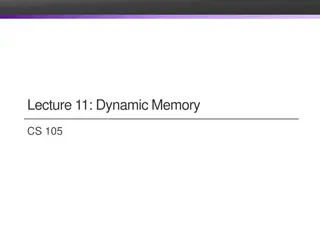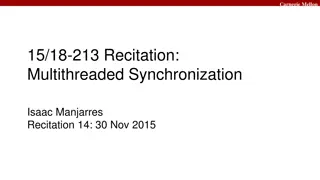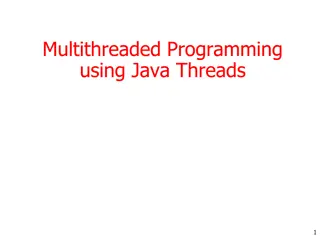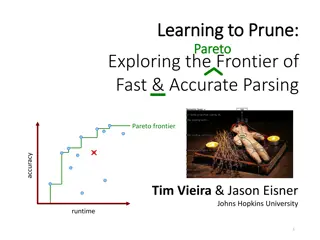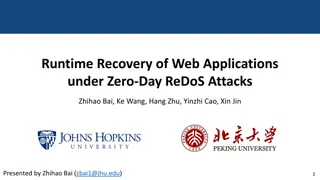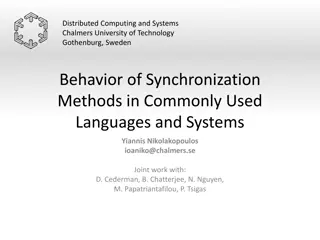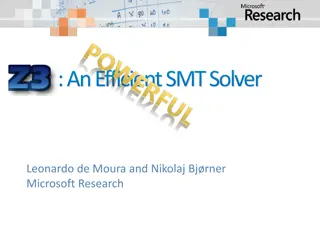CILK: An Efficient Multithreaded Runtime System
CILK is a multithreaded runtime system designed to develop dynamic, asynchronous, and concurrent programs efficiently. It utilizes a work-stealing thread scheduler and relies on a directed acyclic graph (DAG) model for computations. With a focus on optimizing critical paths and total work, CILK enables non-blocking, concurrent execution of threads within procedures, enhancing performance and scalability.
Download Presentation

Please find below an Image/Link to download the presentation.
The content on the website is provided AS IS for your information and personal use only. It may not be sold, licensed, or shared on other websites without obtaining consent from the author.If you encounter any issues during the download, it is possible that the publisher has removed the file from their server.
You are allowed to download the files provided on this website for personal or commercial use, subject to the condition that they are used lawfully. All files are the property of their respective owners.
The content on the website is provided AS IS for your information and personal use only. It may not be sold, licensed, or shared on other websites without obtaining consent from the author.
E N D
Presentation Transcript
CILK: An Efficient Multithreaded Runtime System
People Project at MIT & now at UT Austin Bobby Blumofe (now UT Austin, Akamai) Chris Joerg Brad Kuszmaul (now Yale) Charles Leiserson (MIT, Akamai) Keith Randall (Bell Labs) Yuli Zhou (Bell Labs)
Outline Introduction Programming environment The work-stealing thread scheduler Performance of applications Modeling performance Proven Properties Conclusions
Introduction Why multithreading? To implement dynamic, asynchronous, concurrent programs. Cilk programmer optimizes: total work critical path A Cilk computation is viewed as a dynamic, directed acyclic graph (dag)
Introduction ... Cilk program is a set of procedures A procedure is a sequence of threads Cilk threads are: represented by nodes in the dag Non-blocking: run to completion: no waiting or suspension: atomic units of execution
Introduction ... Threads can spawn child threads downward edges connect a parent to its children A child & parent can run concurrently. Non-blocking threads a child cannot return a value to its parent. The parent spawns a successor that receives values from its children
Introduction ... A thread & its successor are parts of the same Cilk procedure. connected by horizontal arcs Children s returned values are received before their successor begins: They constitute data dependencies. Connected by curved arcs
Introduction: Execution Time Execution time of a Cilk program using P processors depends on: Work (T1): time for Cilk program with 1 processor to complete. Critical path (T ): the time to execute the longest directed path in the dag. TP >= T1 / P (not true for some searches) TP >= T
Introduction: Scheduling Cilk uses run time scheduling called work stealing. Works well on dynamic, asynchronous, MIMD-style programs. For fully strict programs, Cilk achieves asymptotic optimality for: space, time, & communication
Introduction: language Cilk is an extension of C Cilk programs are: preprocessed to C linked with a runtime library
Programming Environment Declaring a thread: thread T ( <args> ) { <stmts> } T is preprocessed into a C function of 1 argument and return type void. The 1 argument is a pointer to a closure
Environment: Closure A closure is a data structure that has: a pointer to the C function for T a slot for each argument (inputs & continuations) a join counter: count of the missing argument values A closure is ready when join counter == 0. A closure is waiting otherwise. They are allocated from a runtime heap
Environment: Continuation A Cilk continuation is a data type, denoted by the keyword cont. cont int x; It is a global reference to an empty slot of a closure. It is implemented as 2 items: a pointer to the closure; (what thread) an int value: the slot number. (what input)
Environment: spawn To spawn a child, a thread creates its closure: spawn T (<args> ) creates child s closure sets available arguments sets join counter To specify a missing argument, prefix with a ? spawn T (k, ?x);
Environment: spawn_next A successor thread is spawned the same way as a child, except the keyword spawn_next is used: spawn_next T(k, ?x) Children typically have no missing arguments; successors do.
Explicit continuation passing Nonblocking threads a parent cannot block on children s results. It spawns a successor thread. This communication paradigm is called explicit continuation passing. Cilk provides a primitive to send a value from one closure to another.
send_argument Cilk provides the primitive send_argument( k, value ) sends value to the argument slot of a waiting closure specified by continuation k. spawn_next successor parent spawn send_argument child
Cilk Procedure for computing a Fibonacci number thread int fib ( cont int k, int n ) { if ( n < 2 ) send_argument( k, n ); else { cont int x, y; spawn_next sum ( k, ?x, ?y ); spawn fib ( x, n - 1 ); spawn fib ( y, n - 2 ); } } thread sum ( cont int k, int x, int y ) { send_argument ( k, x + y ); }
Nonblocking Threads: Advantages Shallow call stack. Simplify runtime system: Completed threads leave C runtime stack empty. Portable runtime implementation
Nonblocking Threads: Disdvantages Burdens programmer with explicit continuation passing.
Work-Stealing Scheduler The concept of work-stealing goes at least as far back as 1981. Work-stealing: a process with no work selects a victim from which to get work. it gets the shallowest thread in the victim s spawn tree. In Cilk, thieves choose victims randomly.
Stealing Work: The Ready Deque Each closure has a level: level( child ) = level( parent ) + 1 level( successor ) = level( parent ) Each processor maintains a ready deque: Contains ready closures The Lth element contains the list of all ready closures whose level is L.
Ready deque if ( ! readyDeque .isEmpty() ) take deepest thread else steal shallowest thread from readyDeque of randomly selected victim
Why Steal Shallowest closure? Shallow threads probably produce more work, therefore, reduce communication. Shallow threads more likely to be on critical path.
Readying a Remote Closure If a send_argument makes a remote closure ready, put closure on sending processor s readyDeque extra communication. Done to make scheduler provably good Putting on local readyDeque works well in practice.
Performance of Application Tserial = time for C program T1 = time for 1-processor Cilk program Tserial /T1 = efficiency of the Cilk program Efficiency is close to 1 for programs with moderately long threads: Cilk overhead is small.
Performance of Applications T1/TP = speedup T1/ T = average parallelism If average parallelism is large then speedup is nearly perfect. If average parallelism is small then speedup is much smaller.
Performance of Applications Application speedup = efficiency X speedup = ( Tserial /T1 ) X ( T1/TP ) = Tserial / TP
Modeling Performance TP >= max( T , T1 / P ) A good scheduler should come close to these lower bounds.
Modeling Performance Empirical data suggests that for Cilk: TP c1 T1 / P + c T , where c1 1.067 & c 1.042 If T1 / T > 10P then critical path does not affect TP.
Proven Property: Time Time: Including overhead, TP = O( T1/P + T ), which is asymptotically optimal
Conclusions We can predict the performance of a Cilk program by observing machine-independent characteristics: Work Critical path when the program is fully-strict. Cilk s usefulness is unclear for other kinds of programs (e.g., iterative programs).
Conclusions ... Explicit continuation passing a nuisance. It subsequently was removed (with more clever pre-processing).
Conclusions ... Great system research has a theoretical underpinning. Such research identifies important properties of the systems themselves, or of our ability to reason about them formally. Cilk identified 3 significant system properties: Fully strict programs Non-blocking threads Randomly choosing a victim.
The Cost of Spawns A spawn is about an order of magnitude more costly than a C function call. Spawned threads running on parent s processor can be implemented more efficiently than remote spawns. This usually is the case. Compiler techniques can exploit this distinction.
Communication Efficiency A request is an attempt to steal work (the victim may not have work). Requests/processor & steals/processor both grow as the critical path grows.
Proven Properties: Space A fully strict program s threads send arguments only to its parent s successors. For such programs, space, time, & communication bounds are proven. Space: SP <= S1 P. There exists a P-processor execution for which this is asymptotically optimal.
Proven Properties: Communication Communication: The expected # of bits communicated in a P-processor execution is: O( T P SMAX ) where SMAX denotes its largest closure. There exists a program such that, for all P, there exists a P-processor execution that communicates k bits, where k > c T P SMAX, for some constant, c.
